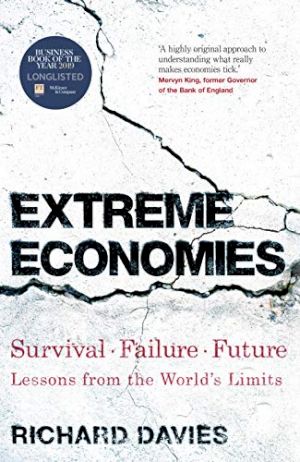24 April 2020
Extreme Economies:
Survival, Failure, Future - Lessons from the World’s Limits
Richard Davies
2019, Bantam Press, 416 pages,
ISBN 9781787631991
Reviewer: Dame Kate Barker

This book is full of surprises. It takes the reader to places and situations previously little-known, or not known at all – and describes how the economic principles normally confined to dry text books play out in startling ways. Davies starts from the observation that developments in medicine and in engineering have been made as a result of examining extreme injuries or dramatic structural failures. His interest is in looking at how economies respond to extreme circumstances: why and how they survive or fail – and how we might need to adapt in the future.
The first of the three examples of survival is the coast of Aceh in Indonesia – where the tsunami struck on Boxing Day 2004. 55% of the population was killed and most buildings destroyed. Yet a decade later, partly due to four years of foreign aid, the economy is vibrant. The contrasting photographs of post-tsunami and ten years on amaze. Why? The answer is that the rebuilding enabled not just better construction, but also opened up the population to greater ambitions, such as understanding the value of education. It also demonstrates the resilience of human capital, combined with an unmeasured economy of loans between friends and other transactions. We often wonder, but don’t learn from, what happens after a tragedy.
The second survival example is Zaatari – a camp for 200,000 Syrian refugees in northern Jordan that has succeeded in becoming economically vibrant and even exporting. This has happened despite the fact that their economic lives were supposed to be under strict control. The answer to the puzzle is that control is in fact lax – so that the goods bought with cards loaded with aid cash can be smuggled from the camp and exchanged for more desired goods. The profits from this activity have enabled a range of businesses to be established. Davies contrasts this with another camp, Azraq, better-built but with tightly-controlled markets which have permitted little entrepreneurship and failed.
The third example was the most eye-opening: a maximum-security prison in Louisiana. Here the lives of the inmates are apparently hopeless, with small amounts earned from slave farming. Yet drugs and other goods are smuggled in, and all through the use of pre-paid cards which have numbers on the back. The numbers are told to the prisoners, who can use them to enable guards illicitly to benefit from the credit – an ingenious form of cash that enables a prison economy which in turn keeps the prisoners more sane and content.
The three examples of failure are swifter to describe. The Darien Gap is lawless and risky – this hampers trade, and the lack of regulation means excess exploitation of natural resources in a tragedy of the commons. Kinshasa in the Congo has much extreme poverty – due largely to the prevalence of corruption among public officials, and the state’s failure to provide adequate infrastructure. These work against the natural entrepreneurship of much of the population. Last in this group is Glasgow – a more familiar story of a combination of mis-managed industrial decline with consequences exacerbated by housing policy (resettling people away from their social connections to brutal high-rise flats in peripheral suburbs lacking public transport).
For the future, Davies looks at ageing (Akita in Japan where a third of the population is over 65); the digital state (Tallinn in Estonia) and inequality (Santiago in Chile). He comments that: “The year 2030, for most people on earth, will be a cocktail of these three cities: an urban society that is old, technologically advanced and economically unequal.” The three examples each give a window into this future which has positives and negatives – all of which we can learn from.
This is a very enjoyable book to read – Davies describes meeting many extraordinary people and it is full of examples of human resilience, alongside depressing stories of policy failure, or policy inattention, which leave many immiserated. Of his main conclusions one is familiar – that markets can be forces for great good or great ill. But he also draws out many examples where human capital and social capital weave the fabric of an informal economy to produce startlingly positive results from an unpromising situation.
Just as startling are the examples which confirm the truth of Friedman’s observation that “One of the great mistakes is to judge policies and programs by their intentions rather than their results”. Here the most depressing example is the Darien teak subsidies. But we will all have our favourites closer to home.
